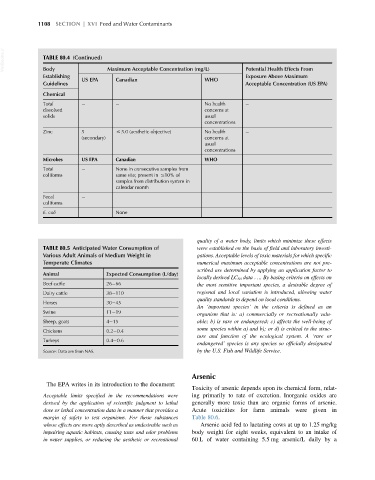Page 1176 - Veterinary Toxicology, Basic and Clinical Principles, 3rd Edition
P. 1176
1108 SECTION | XVI Feed and Water Contaminants
VetBooks.ir TABLE 80.4 (Continued)
Body
Exposure Above Maximum
Establishing Maximum Acceptable Concentration (mg/L) Potential Health Effects From
US EPA Canadian WHO
Guidelines Acceptable Concentration (US EPA)
Chemical
Total No health
dissolved concerns at
solids usual
concentrations
Zinc 5 # 5.0 (aesthetic objective) No health
(secondary) concerns at
usual
concentrations
Microbes US EPA Canadian WHO
Total None in consecutive samples from
coliforms same site; present in #10% of
samples from distribution system in
calendar month
Fecal
coliforms
E. coli None
quality of a water body, limits which minimize these effects
TABLE 80.5 Anticipated Water Consumption of were established on the basis of field and laboratory investi-
Various Adult Animals of Medium Weight in gations. Acceptable levels of toxic materials for which specific
Temperate Climates numerical maximum acceptable concentrations are not pre-
scribed are determined by applying an application factor to
Animal Expected Consumption (L/day)
locally derived LC 50 data .. .. By basing criteria on effects on
Beef cattle 26 66 the most sensitive important species, a desirable degree of
Dairy cattle 38 110 regional and local variation is introduced, allowing water
quality standards to depend on local conditions.
Horses 30 45
An ‘important species’ in the criteria is defined as an
Swine 11 19 organism that is: a) commercially or recreationally valu-
Sheep, goats 4 15 able; b) is rare or endangered; c) affects the well-being of
some species within a) and b); or d) is critical to the struc-
Chickens 0.2 0.4
ture and function of the ecological system. A ‘rare or
Turkeys 0.4 0.6
endangered’ species is any species so officially designated
Source: Data are from NAS. by the U.S. Fish and Wildlife Service.
Arsenic
The EPA writes in its introduction to the document:
Toxicity of arsenic depends upon its chemical form, relat-
Acceptable limits specified in the recommendations were ing primarily to rate of excretion. Inorganic oxides are
derived by the application of scientific judgment to lethal generally more toxic than are organic forms of arsenic.
dose or lethal concentration data in a manner that provides a Acute toxicities for farm animals were given in
margin of safety to test organisms. For those substances Table 80.6.
whose effects are more aptly described as undesirable such as Arsenic acid fed to lactating cows at up to 1.25 mg/kg
impairing aquatic habitats, causing taste and odor problems body weight for eight weeks, equivalent to an intake of
in water supplies, or reducing the aesthetic or recreational 60 L of water containing 5.5 mg arsenic/L daily by a

